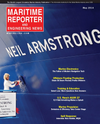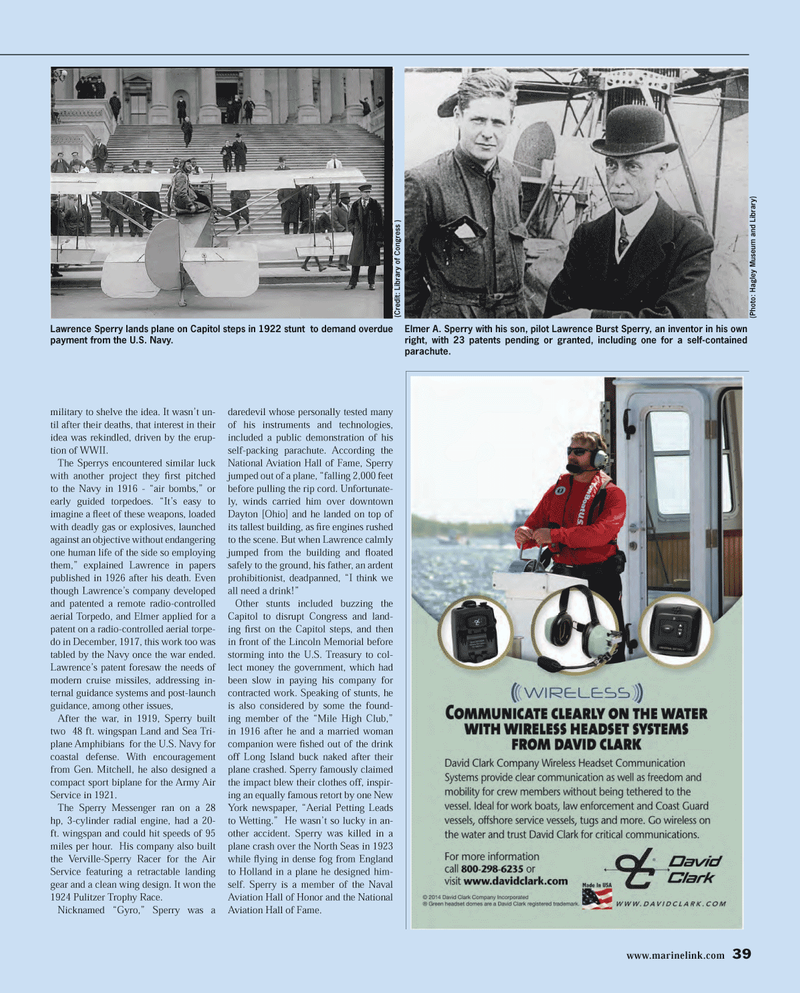
Page 39: of Maritime Reporter Magazine (May 2014)
Marine Electronics Edition
Read this page in Pdf, Flash or Html5 edition of May 2014 Maritime Reporter Magazine
www.marinelink.com 39 (Photo: Hagley Museum and Library)
Elmer A. Sperry with his son, pilot Lawrence Burst Sperry, an inventor in his own right, with 23 patents pending or granted, including one for a self-contained parachute. (Cr edit: Library of Congr ess )
Lawrence Sperry lands plane on Capitol steps in 1922 stunt to demand overdue payment from the U.S. Navy. military to shelve the idea. It wasn’t un- til after their deaths, that interest in their idea was rekindled, driven by the erup- tion of WWII.
The Sperrys encountered similar luck with another project they fi rst pitched to the Navy in 1916 - “air bombs,” or early guided torpedoes. “It’s easy to imagine a fl eet of these weapons, loaded with deadly gas or explosives, launched against an objective without endangering one human life of the side so employing them,” explained Lawrence in papers published in 1926 after his death. Even though Lawrence’s company developed and patented a remote radio-controlled aerial Torpedo, and Elmer applied for a patent on a radio-controlled aerial torpe- do in December, 1917, this work too was tabled by the Navy once the war ended.
Lawrence’s patent foresaw the needs of modern cruise missiles, addressing in- ternal guidance systems and post-launch guidance, among other issues,
After the war, in 1919, Sperry built two 48 ft. wingspan Land and Sea Tri- plane Amphibians for the U.S. Navy for coastal defense. With encouragement from Gen. Mitchell, he also designed a compact sport biplane for the Army Air
Service in 1921.
The Sperry Messenger ran on a 28 hp, 3-cylinder radial engine, had a 20- ft. wingspan and could hit speeds of 95 miles per hour. His company also built the Verville-Sperry Racer for the Air
Service featuring a retractable landing gear and a clean wing design. It won the 1924 Pulitzer Trophy Race.
Nicknamed “Gyro,” Sperry was a daredevil whose personally tested many of his instruments and technologies, included a public demonstration of his self-packing parachute. According the
National Aviation Hall of Fame, Sperry jumped out of a plane, “falling 2,000 feet before pulling the rip cord. Unfortunate- ly, winds carried him over downtown
Dayton [Ohio] and he landed on top of its tallest building, as fi re engines rushed to the scene. But when Lawrence calmly jumped from the building and fl oated safely to the ground, his father, an ardent prohibitionist, deadpanned, “I think we all need a drink!”
Other stunts included buzzing the
Capitol to disrupt Congress and land- ing fi rst on the Capitol steps, and then in front of the Lincoln Memorial before storming into the U.S. Treasury to col- lect money the government, which had been slow in paying his company for contracted work. Speaking of stunts, he is also considered by some the found- ing member of the “Mile High Club,” in 1916 after he and a married woman companion were fi shed out of the drink off Long Island buck naked after their plane crashed. Sperry famously claimed the impact blew their clothes off, inspir- ing an equally famous retort by one New
York newspaper, “Aerial Petting Leads to Wetting.” He wasn’t so lucky in an- other accident. Sperry was killed in a plane crash over the North Seas in 1923 while fl ying in dense fog from England to Holland in a plane he designed him- self. Sperry is a member of the Naval
Aviation Hall of Honor and the National
Aviation Hall of Fame.
MR #5 (32-41).indd 39 4/29/2014 12:22:21 PM

 38
38

 40
40
